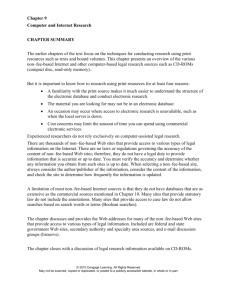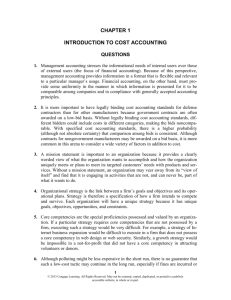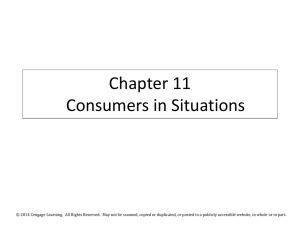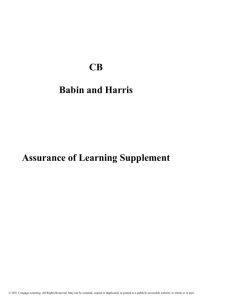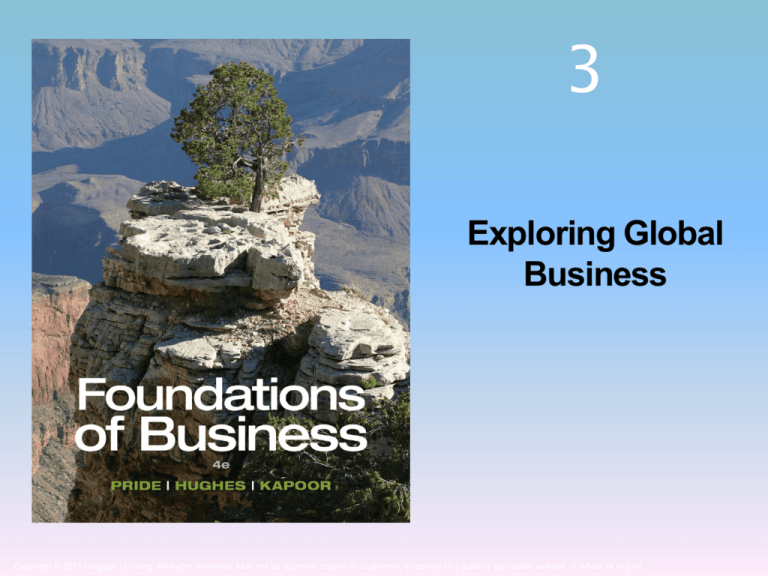
3
Exploring Global
Business
Copyright ©2015 Cengage Learning. All Rights Reserved. May not be scanned, copied or duplicated, or posted to a publicly accessible website, in whole or in part.
Learning Objectives
① Explain the economic basis for international business.
② Discuss the restrictions nations place on international
trade, the objectives of these restrictions, and their results.
③ Outline the extent of international trade and the world
economic outlook for trade.
④ Discuss international trade agreements and international
economic organizations working to foster trade.
⑤ Define the methods by which a firm can organize for and
enter into international markets.
⑥ Describe the various sources of export assistance.
⑦ Identify the institutions that help firms and nations finance
international business.
Copyright ©2015 Cengage Learning. All Rights Reserved. May not be scanned, copied or duplicated, or posted to a publicly accessible website, in whole or in part.
2
Absolute Advantage
Absolute Advantage is the ability to produce a
specific product more efficiently than any other
nation.
South Africa - Diamonds
Australia - Wool
© DVARG/SHUTTERSTOCK
© AKAISER/SHUTTERSTOCK
© ILDOGESTO/SHUTTERSTOCK
Saudi Arabia – Crude Oil
© ILEYSEN/SHUTTERSTOCK
Copyright ©2015 Cengage Learning. All Rights Reserved. May not be scanned, copied or duplicated, or posted to a publicly accessible website, in whole or in part.
3
Comparative Advantage
Comparative Advantage is the ability to produce
a specific product more efficiently than any other
product.
Maximum
Outputs
Country
A
Country
B
Automobiles
30m
45m
Motorcycles
6m
18m
Country B has absolute
advantage in both products,
but a comparative advantage
in motorcycles because it is
relatively better at producing
them.
Country B is 3 times better at
motorcycles, but only 1.5
times better at cars.
Copyright ©2015 Cengage Learning. All Rights Reserved. May not be scanned, copied or duplicated, or posted to a publicly accessible website, in whole or in part.
4
Exporting and Importing
U.S. Exports
Excess
Wine
Excess
Corn
U.S. Imports
Countries trade when they each have a surplus of
the product in which they specialize and want a
product in which the other country specializes.
Copyright ©2015 Cengage Learning. All Rights Reserved. May not be scanned, copied or duplicated, or posted to a publicly accessible website, in whole or in part.
5
Exports by State
Copyright ©2015 Cengage Learning. All Rights Reserved. May not be scanned, copied or duplicated, or posted to a publicly accessible website, in whole or in part.
6
Balance of Trade
Balance of trade is the total value of a nation's
exports minus the total value of its imports over
some period of time.
Imports
Exports
Copyright ©2015 Cengage Learning. All Rights Reserved. May not be scanned, copied or duplicated, or posted to a publicly accessible website, in whole or in part.
7
U.S. International Trade
in Goods and Services
Copyright ©2015 Cengage Learning. All Rights Reserved. May not be scanned, copied or duplicated, or posted to a publicly accessible website, in whole or in part.
8
Trade Deficit
Trade deficit is a negative (unfavorable)
balance of trade where imports exceed exports
in value.
Copyright ©2015 Cengage Learning. All Rights Reserved. May not be scanned, copied or duplicated, or posted to a publicly accessible website, in whole or in part.
9
US International Trade Deficit
Source: http://www.bea.gov/newsreleases/international/trade/2012/pdf/trad0812.pdf
Copyright ©2015 Cengage Learning. All Rights Reserved. May not be scanned, copied or duplicated, or posted to a publicly accessible website, in whole or in part.
10
Reasons for Trade Restrictions
What are some
reasons a country
would want to
restrict trade?
© STUART MILES/SHUTTERSTOCK
Copyright ©2015 Cengage Learning. All Rights Reserved. May not be scanned, copied or duplicated, or posted to a publicly accessible website, in whole or in part.
11
Nations are generally eager to
export their products to provide
markets for their industries and
develop a favorable balance of
trade.
Most trade restrictions
are applied to imports
from other countries.
© ALBO003/SHUTTERSTOCK
© ALBO003/SHUTTERSTOCK
Restrictions to International Business
Copyright ©2015 Cengage Learning. All Rights Reserved. May not be scanned, copied or duplicated, or posted to a publicly accessible website, in whole or in part.
12
Trade with China, July 2013
© ILDOGESTO/SHUTTERSTOCK
United States imports more goods from
China than any other nation in the world.
Exports
$8.7 Billion
Imports
$38.8 Billion
Balance -$30.1 Billion
Copyright ©2015 Cengage Learning. All Rights Reserved. May not be scanned, copied or duplicated, or posted to a publicly accessible website, in whole or in part.
13
Types of Trade Restrictions: Tariffs
An Import duty (tariff)
is a tax levied on a particular
foreign product entering
a country.
Revenue tariffs are
imposed to generate
income for the government.
Protective tariffs are imposed
to protect a domestic industry from competition
by keeping the prices of imports at or above
the price of domestic products.
Copyright ©2015 Cengage Learning. All Rights Reserved. May not be scanned, copied or duplicated, or posted to a publicly accessible website, in whole or in part.
14
Types of Trade Restrictions: Dumping
Dumping is the exportation of large quantities of
a product at a price lower than that of the same
product in the home market.
The U.S. Commerce
Department has imposed
anti-dumping tariffs and
anti-subsidy tariffs on
Chinese solar panels to
combat dumping.
© FILIP FUXA/SHUTTERSTOCK
Copyright ©2015 Cengage Learning. All Rights Reserved. May not be scanned, copied or duplicated, or posted to a publicly accessible website, in whole or in part.
15
Types of Trade Restrictions:
Nontariff Barriers
Nontariff barriers—nontax measures imposed by a
government to favor domestic over foreign suppliers
Import quota—a limit on the amount of a particular
good that may be imported during a given time
Embargo—a complete halt to trading with a particular
nation or in a particular product. Embargoes may be
imposed to accomplish foreign policy and national
security goals.
Foreign exchange control—restriction on amount of
foreign currency that can be purchased or sold
₤€¥$
Copyright ©2015 Cengage Learning. All Rights Reserved. May not be scanned, copied or duplicated, or posted to a publicly accessible website, in whole or in part.
16
Types of Trade Restrictions:
Nontariff Barriers (cont’d)
Currency devaluation is the
reduction of the value of a nation’s
currency relative to the currencies
of other countries.
Bureaucratic red tape subtly
imposes unnecessarily
burdensome and complex
standards and requirements for
imported goods.
© MILAN LJUBISAVIJEVIC/SHUTTERSTOCK
Cultural attitudes can impede
acceptance of products in foreign
countries.
Copyright ©2015 Cengage Learning. All Rights Reserved. May not be scanned, copied or duplicated, or posted to a publicly accessible website, in whole or in part.
17
Types of Trade Restrictions:
Cultural Attitudes
How important is
it to you that your
goods are made in
the U.S.A?
© MYPIXXX/SHUTTERSTOCK
Copyright ©2015 Cengage Learning. All Rights Reserved. May not be scanned, copied or duplicated, or posted to a publicly accessible website, in whole or in part.
18
Reasons for Trade Restrictions
To equalize a nation’s
balance of payments
To protect new or
weak industries
To protect
national security
To protect the health
of citizens
To retaliate for another nation’s trade restrictions
To protect domestic jobs
© FIKMIK/SHUTTERSTOCK
Copyright ©2015 Cengage Learning. All Rights Reserved. May not be scanned, copied or duplicated, or posted to a publicly accessible website, in whole or in part.
19
Reasons Against Trade Restrictions
Higher prices for
consumers
Restriction of
consumers’ choices
Misallocation of
international
resources
© FIKMIK/SHUTTERSTOCK
Loss of jobs
Copyright ©2015 Cengage Learning. All Rights Reserved. May not be scanned, copied or duplicated, or posted to a publicly accessible website, in whole or in part.
20
The Extent of International Business
Although the worldwide recessions of 1991 and 20012002 slowed the rate of growth, and 2008-2009 global
economic crisis caused the sharpest decline in more
than 70 years, globalization is a reality of our time.
Copyright ©2015 Cengage Learning. All Rights Reserved. May not be scanned, copied or duplicated, or posted to a publicly accessible website, in whole or in part.
21
The Extent of International Business (cont’d)
Trade barriers are decreasing, new
competitors are entering the global
marketplace, creating more choices for
consumers and new job opportunities.
International business will grow with the
expansion of commercial use of the Internet.
Copyright ©2015 Cengage Learning. All Rights Reserved. May not be scanned, copied or duplicated, or posted to a publicly accessible website, in whole or in part.
22
The World Economic Outlook for Trade
Copyright ©2015 Cengage Learning. All Rights Reserved. May not be scanned, copied or duplicated, or posted to a publicly accessible website, in whole or in part.
23
The World Economic Outlook for Trade
Economic performance among nations is not
equal; growth in advanced countries slowed
and then stopped in 2009, while emerging and
developing economies continue to grow
rapidly.
International experts expected global
economic growth in 2010 and 2011, despite
the high oil prices.
Copyright ©2015 Cengage Learning. All Rights Reserved. May not be scanned, copied or duplicated, or posted to a publicly accessible website, in whole or in part.
24
The World Economic Outlook for Trade:
Canada
Canada is the U.S.’s
leading export partner.
© ILDOGESTO/SHUTTERSTOCK
Projected Growth
• 2013: 1.8%
• 2014: 2.3%
2012 U.S. goods Trade
Deficit with Canada:
-$32 Billion
Copyright ©2015 Cengage Learning. All Rights Reserved. May not be scanned, copied or duplicated, or posted to a publicly accessible website, in whole or in part.
25
FLAGS: © IINTS VIKMANIS/SHUTTERSTOCK
MAPS: © ILDOGESTO/SHUTTERSTOCK
The World Economic Outlook for Trade:
EU and UK
Euro Area Projected Growth
• 2013: -0.2%
• 2014: 1.0%
2011 Trade Deficit: -$99,88.0B
United Kingdom Projected Growth
• 2013: 1.0%
• 2014: 1.9%
2011 Trade Deficit: +$4,664.6B
Copyright ©2015 Cengage Learning. All Rights Reserved. May not be scanned, copied or duplicated, or posted to a publicly accessible website, in whole or in part.
26
FLAGS: © IINTS VIKMANIS/SHUTTERSTOCK
MAPS: © ILDOGESTO/SHUTTERSTOCK
The World Economic Outlook for Trade:
Japan and China
Japan Projected Growth
• 2013: 1.2%
• 2014: 0.7%
2011 Trade Deficit: -$63,218.5B
China Projected Growth
• 2013: 8.2%
• 2014: 8.5%
Generates 25% of world
GDP growth
Copyright ©2015 Cengage Learning. All Rights Reserved. May not be scanned, copied or duplicated, or posted to a publicly accessible website, in whole or in part.
27
FLAGS: © IINTS VIKMANIS/SHUTTERSTOCK
MAPS: © ILDOGESTO/SHUTTERSTOCK
The World Economic Outlook:
India and ASEAN-5 Countries
India Projected Growth
• 2013: 5.9%
• 2014: 6.4%
2011 Trade Deficit: -$14,651.5B
Indonesia, Malaysia,
Philippines, Thailand, Vietnam
ASEAN-5 Projected Growth
• 2013: 5.5%
• 2014: 5.7%
2011 Trade Deficit: -$51,775.8B
Copyright ©2015 Cengage Learning. All Rights Reserved. May not be scanned, copied or duplicated, or posted to a publicly accessible website, in whole or in part.
28
The World Economic Outlook for Trade
Commonwealth of Independent States
Commonwealth of Independent States
• Projected to show growth in 2013 and 2014.
• With the collapse of communism, trade between
the U.S. and central and Eastern Europe
expanded substantially.
• Countries that transitioned from communism to
market economies are growing; those that have
not transitioned continue to struggle.
Armenia, Azerbaijan, Belarus, Kazakhstan, Kyrgyzstan,
Moldova, Russia, Tajikistan, Uzbekistan
© ILDOGESTO/SHUTTERSTOCK
Copyright ©2015 Cengage Learning. All Rights Reserved. May not be scanned, copied or duplicated, or posted to a publicly accessible website, in whole or in part.
29
Exports and the U.S. Economy
Exports as a percentage of GDP:
• Record high of 12.9% in 2008
• 2010: 12.7%; 2011: 13.8%
In 2011, exports were up 14.5%
to $2.15 trillion while imports
were up 13.8% to $2.66 trillion.
Largest merchandise export
markets in 2012:
• Canada: $270.1B
• Mexico: $199.9B
• China: $100.2B
Copyright ©2015 Cengage Learning. All Rights Reserved. May not be scanned, copied or duplicated, or posted to a publicly accessible website, in whole or in part.
30
Largest Trading Partners for U.S.
Copyright ©2015 Cengage Learning. All Rights Reserved. May not be scanned, copied or duplicated, or posted to a publicly accessible website, in whole or in part.
31
U.S. Goods Export and
Import Shares in 2012
Copyright ©2015 Cengage Learning. All Rights Reserved. May not be scanned, copied or duplicated, or posted to a publicly accessible website, in whole or in part.
32
International Trade Agreements
WTO
World Trade Organization (WTO)
Oversees GATT provisions
Has judicial powers to meditate trade disputes
arising from GATT rules
Exerts more binding authority than GATT
Copyright ©2015 Cengage Learning. All Rights Reserved. May not be scanned, copied or duplicated, or posted to a publicly accessible website, in whole or in part.
33
WTO Members Share in
World Merchandise Trade, 2011
Copyright ©2015 Cengage Learning. All Rights Reserved. May not be scanned, copied or duplicated, or posted to a publicly accessible website, in whole or in part.
34
World Trade and
the Global Economic Crisis
“The multilateral trading system
has been instrumental in
maintaining trade openness
during the [global financial]
crisis, thereby avoiding even
worse outcomes. Members
must remain vigilant. This is the
time to strengthen and preserve
the global trading system so
that it keeps performing this vital
function in the future.”
© ANWEBER/SHUTTERSTOCK
--WTO Director-General Pascal Lamy,
2012
Copyright ©2015 Cengage Learning. All Rights Reserved. May not be scanned, copied or duplicated, or posted to a publicly accessible website, in whole or in part.
35
World Trade and
the Global Economic Crisis
Copyright ©2015 Cengage Learning. All Rights Reserved. May not be scanned, copied or duplicated, or posted to a publicly accessible website, in whole or in part.
© ROBOLAB/SHUTTERSTOCK
Do you think the
interconnectedness
of the global
economy helped or
exacerbated the
global economic
crisis?
36
International Economic Organizations:
The Evolving European Union
The European
Union is now an
economic force,
with a collective
economy larger
than that of the
United States or
Japan.
Copyright ©2015 Cengage Learning. All Rights Reserved. May not be scanned, copied or duplicated, or posted to a publicly accessible website, in whole or in part.
37
FLAGS: © IINTS VIKMANIS/SHUTTERSTOCK
MAPS: © ILDOGESTO/SHUTTERSTOCK
International Economic Organizations:
NAFTA
North American Free
Trade Agreement (NAFTA)
The United States
Canada
Mexico
Copyright ©2015 Cengage Learning. All Rights Reserved. May not be scanned, copied or duplicated, or posted to a publicly accessible website, in whole or in part.
38
International Economic Organizations:
NAFTA
Support
Criticism
Contributes to significant
increases in trade and
investment
Benefits companies in all
three countries
Results in increased
sales, new partnerships,
and new opportunities
Creates high-paying
export-related jobs
Leads to better prices and
selection in consumer
goods
Has not achieved its goals
Resulted in job losses
Erodes labor standards
and lowers wages
Undermines national
sovereignty and
independence
Does nothing to help the
environment
Hurts the agricultural
sector
Copyright ©2015 Cengage Learning. All Rights Reserved. May not be scanned, copied or duplicated, or posted to a publicly accessible website, in whole or in part.
39
FLAGS: © IINTS VIKMANIS/SHUTTERSTOCK
MAPS: © ILDOGESTO/SHUTTERSTOCK
International Economic Organizations:
CAFTA-DR
Central American Free Trade
Agreement – Dominican
Republic (CAFTA-DR) Est. 2003
El Salvador
Nicaragua
Guatemala
Dominican Republic
Honduras
Costa Rica
Copyright ©2015 Cengage Learning. All Rights Reserved. May not be scanned, copied or duplicated, or posted to a publicly accessible website, in whole or in part.
40
FLAGS: © IINTS VIKMANIS/SHUTTERSTOCK
MAPS: © ILDOGESTO/SHUTTERSTOCK
International Economic Organizations:
ASEAN
Association of Southeast Asian Nations
(ASEAN) Est. 1967
Brunei
Malaysia
Myanmar
Philippines
Cambodia
Singapore
Indonesia
Thailand
Laos
Vietnam
Copyright ©2015 Cengage Learning. All Rights Reserved. May not be scanned, copied or duplicated, or posted to a publicly accessible website, in whole or in part.
41
FLAGS: © IINTS VIKMANIS/SHUTTERSTOCK
MAPS: © ILDOGESTO/SHUTTERSTOCK
International Economic Organizations:
OPEC
Organization of Petroleum Exporting Countries
(OPEC), Est. 1960
Algeria
Indonesia
Qatar
United Arab Emirates
Saudi Arabia
Venezuela
Iran
Iraq
Kuwait
Libya
Nigeria
Copyright ©2015 Cengage Learning. All Rights Reserved. May not be scanned, copied or duplicated, or posted to a publicly accessible website, in whole or in part.
42
International Economic Organizations:
Others
The Commonwealth of Independent States,
Est. 1991
Trans-Pacific Partnership (TPP), Est. 2011
Commonwealth of Independent States
(CIS), Est. 1991
Caribbean Basin Initiative (CBI)
Common Market of the Southern Cone
(MERCOSUR), Est. 1991
Organization of Petroleum Exporting
Countries (OPEC), Est. 1960
Copyright ©2015 Cengage Learning. All Rights Reserved. May not be scanned, copied or duplicated, or posted to a publicly accessible website, in whole or in part.
43
Methods of Entering International
Business: Licensing
Licensing is a contractual agreement in which one
firm permits another to produce and market its product
and use its brand name in return for a royalty or other
compensation.
• Advantage
- It allows expansion into foreign markets with
little or no direct investment.
• Disadvantages
- The product image may be damaged if
standards are not upheld.
- The original producer does not gain foreign
marketing experience.
Copyright ©2015 Cengage Learning. All Rights Reserved. May not be scanned, copied or duplicated, or posted to a publicly accessible website, in whole or in part.
44
Methods of Entering International
Business: Exporting
Exporting
• May use an export/import merchant who assumes
the risks of ownership, distribution, and sale
• Letter of credit - Issued by a bank on request of an
importer stating that the bank will pay an amount of
money to a stated beneficiary
• Bill of lading - Issued by a transport carrier to an
exporter to prove merchandise has been shipped
• Draft - Issued by the exporter’s bank, ordering the
importer’s bank to pay for the merchandise, thus
guaranteeing payment once accepted by the
importer’s bank
Copyright ©2015 Cengage Learning. All Rights Reserved. May not be scanned, copied or duplicated, or posted to a publicly accessible website, in whole or in part.
45
Methods of Entering International
Business: Exporting (cont’d)
Exporting (cont’d)
• May use an export/import
agent who arranges sale for
a commission or fee; the
exporter retains title to
products until they are sold
• May establish own sales
offices or branches in foreign
countries
Copyright ©2015 Cengage Learning. All Rights Reserved. May not be scanned, copied or duplicated, or posted to a publicly accessible website, in whole or in part.
46
Using the Internet
“Our Mission:
To Help U.S. Business Succeed, Globally.”
The International Trade Administration of the U.S.
Department of Commerce (ITA) website has links to
statistics, industry analysis, trade laws, and answers
to often-asked trade questions.
www.ita.doc.gov
Copyright ©2015 Cengage Learning. All Rights Reserved. May not be scanned, copied or duplicated, or posted to a publicly accessible website, in whole or in part.
47
Organizing for
International Business
Licensing
Exporting
Joint-Venture
Totally Owned Facilities
Strategic Alliances
Trading Companies
Countertrade
Multinational Firm
Copyright ©2015 Cengage Learning. All Rights Reserved. May not be scanned, copied or duplicated, or posted to a publicly accessible website, in whole or in part.
48
Methods of Entering International
Business: Joint Ventures
A joint venture is a partnership formed to achieve a
specific goal or to operate for a specific period of time.
• Advantages
- Immediate market knowledge and access
- Reduced risk
- Control over the product attributes
• Disadvantages
- Complexity of establishing agreements across
national borders
- High level of commitment required of all
parties involved
Copyright ©2015 Cengage Learning. All Rights Reserved. May not be scanned, copied or duplicated, or posted to a publicly accessible website, in whole or in part.
49
Methods of Entering International
Business: Totally Owned Facilities
Totally owned facilities refers to production and
marketing facilities developed by a firm in one or more
foreign nations.
• Advantage
- Direct investment provides complete control
over operations.
• Disadvantage
- Risk is greater than that of a joint venture.
• Two forms
- Building new facilities in the foreign country
- Purchasing an existing firm in the foreign country
Copyright ©2015 Cengage Learning. All Rights Reserved. May not be scanned, copied or duplicated, or posted to a publicly accessible website, in whole or in part.
50
Methods of Entering International
Business: Strategic Alliances
Strategic alliances are partnerships
formed to create competitive advantage on
a worldwide basis.
Copyright ©2015 Cengage Learning. All Rights Reserved. May not be scanned, copied or duplicated, or posted to a publicly accessible website, in whole or in part.
51
Methods of Entering International
Business: Trading Companies
Copyright ©2015 Cengage Learning. All Rights Reserved. May not be scanned, copied or duplicated, or posted to a publicly accessible website, in whole or in part.
© ROBOLAB/SHUTTERSTOCK
Trading companies are firms that
provide a link between buyers and
sellers in different countries.
• Buys products in one
country at the lowest
price consistent with
quality and sells to
buyers in another country
• Takes title to products and
perform all the activities
necessary to move the products
from one country to another
52
Methods of Entering International
Business: Countertrade
Countertrade is an international barter transaction.
Early 1990s: Many developing nations had major
restrictions on converting domestic currency into foreign
currency. Countertrade avoids restrictions on converting
domestic currency to foreign currency.
© BOJANOVIC/SHUTTERSTOCK
© DVARG/SHUTTERSTOCK
Crude Oil Exchanged for Planes
Copyright ©2015 Cengage Learning. All Rights Reserved. May not be scanned, copied or duplicated, or posted to a publicly accessible website, in whole or in part.
53
Methods of Entering International
Business: Multinational Enterprise
Multinational enterprise refers to firms that operate on a
worldwide scale without ties to any specific nation or region.
Copyright ©2015 Cengage Learning. All Rights Reserved. May not be scanned, copied or duplicated, or posted to a publicly accessible website, in whole or in part.
54
Methods of Entering International Business:
Steps in Entering International Markets
1.
2.
3.
4.
5.
6.
7.
8.
9.
Identify exportable products.
Identify key foreign markets for the products.
Analyze how to sell in each priority market.
Set export prices and payment terms, methods,
and techniques.
Estimate resource requirements and returns.
Establish overseas distribution network.
Determine shipping, traffic, and documentation
procedures and requirements.
Promote, sell, and be paid.
Continuously analyze current marketing,
economic, and political situations.
Copyright ©2015 Cengage Learning. All Rights Reserved. May not be scanned, copied or duplicated, or posted to a publicly accessible website, in whole or in part.
55
Sources of Export Assistance:
NEI
National Export Initiative (NEI)
Announced August 2010 by President Obama
Goal: Revitalize U.S. exports
Means: Federal Agencies assist U.S. firms in developing
export-promotion programs to compete in foreign markets
and create jobs in the U.S. (some examples below)
Federal Agency
Assistance
International Trade Administration
Domestic and overseas commercial officers
provide assistance and information.
Advocacy Center
Facilitates advocacy to assist U.S. firms
competing for major projects and procurements
worldwide.
National Trade Data Bank
Provides international economic and exportpromotion information from more than 20 U.S.
agencies.
Copyright ©2015 Cengage Learning. All Rights Reserved. May not be scanned, copied or duplicated, or posted to a publicly accessible website, in whole or in part.
56
Financing International Business
The Export-Import Bank of the United States (Ex-Im Bank) is
an independent agency of the U.S. government whose function it
is to assist in financing the exports of American firms.
Multilateral Development Bank (MDB) is an internationallysupported bank that provides loans to developing countries to
help them grow.
• World Bank, Inter-American Development Bank (IDB), Asian
Development Bank (ADB), African Development Bank (AFDB),
European Bank for Reconstruction and Development (EBRD)
The International Monetary Fund (IMF) is an international bank
with 186 member nations that makes short-term loans to
developing countries experiencing balance-of-payment deficits.
Copyright ©2015 Cengage Learning. All Rights Reserved. May not be scanned, copied or duplicated, or posted to a publicly accessible website, in whole or in part.
57
The Challenges Ahead
Global economic recovery remains sluggish.
Financial challenges in euro-area economies
slow economic growth.
WTO rules and principles have assisted
governments in keeping markets open and
provide a platform for which the trade can
grow as the global economy improves.
“We see the light at the end of the tunnel and trade promises
to be an important part of the recovery. But we must avoid
derailing any economic revival through protectionism.”
--WTO Director-General Pascal Lamy
Copyright ©2015 Cengage Learning. All Rights Reserved. May not be scanned, copied or duplicated, or posted to a publicly accessible website, in whole or in part.
58




